News
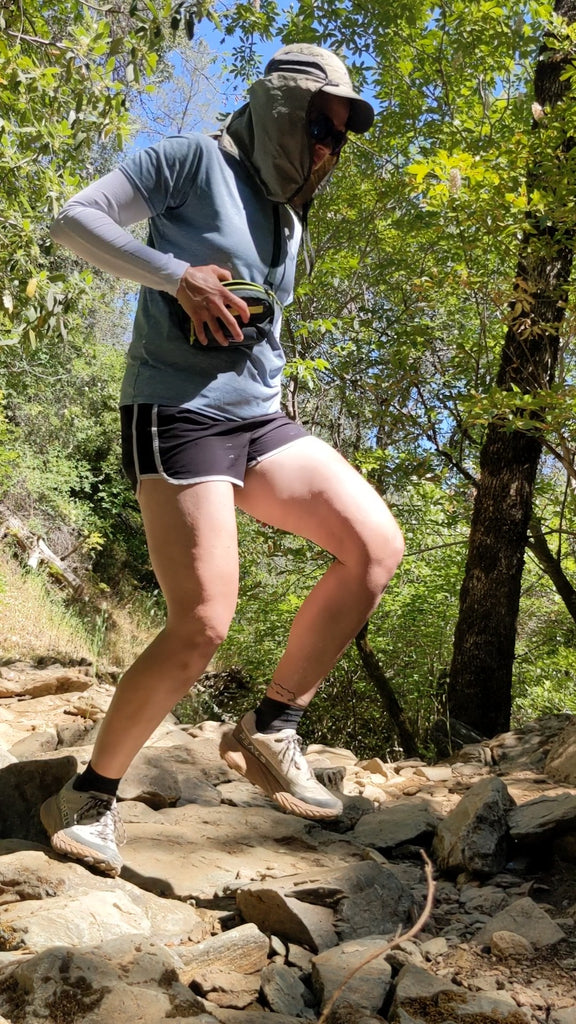
Merrell Agility Peak 5 Review
Merrell Agility Peak 5 Review
Another great offering from Merrell for comfort-oriented hikers and runners alike!
These are another highly-cushioned model, even more so than the La Sportiva Prodigio; you definitely feel like there's a lot between your foot and the ground here. The midsole foam isn't particularly bouncy, but it is very comfortable and not too soft, so it's excellent for long days on the trail. There is a midfoot rock plate for additional protection in rough terrain, though the thick cushion meant that I wasn't worried about feeling any rocks through the sole!
The lug pattern is pretty aggressive, with large, 5mm long, well-spaced, X- and V-shaped lugs that shed mud well and provide good traction on a variety of terrain. The outsole material is Vibram Megagrip, which is probably the most popular rubber compound for trail runners right now, and with good reason. Grip is excellent on rocks and roots as well as dirt and gravel paths. I didn't slip at all while descending several steep, rocky, very dusty slopes with some loose gravel, and I was pretty impressed.
The upper is a big strength of this shoe. It's largely made of a very breathable, flexible mesh; between the upper material and the well-padded tongue and heel collar, Merrell really knocked it out of the park with this upper design. The mesh is reinforced with nylon in all the right places where abrasion and wear are most likely to occur, so it should have some staying power as well, which isn't always the case for engineered mesh uppers.
These are a comfortable fit, as well -- not overly high-volume, but definitely roomy. There's plenty of space in the toe box, and the flexible mesh means that these should be comfortable for people with a variety of different foot shapes. If anything, I found that they fit a bit large - consider trying on a half size down from your usual, just in case. The flat laces stay tied and work well to lock down the foot for added precision. The arch support isn't overly noticeable, but it is there, and it's pretty consistent in terms of shape/placement with most of Merrell's other offerings.
As is the case with most maximally cushioned shoes, the thick cushion comes at the cost of a bit of stability, as you're higher off the ground than you would be with a more minimal shoe. This isn't a problem for most people, but may be an adjustment if you spend most of your time in thin-soled shoes.
Overall, a great shoe for hiking and running all year round, but especially in summer, due to the comfy and breathable upper material!
People who should try on this shoe:
-trail runners!
-people who appreciate or have been recommended maximally-cushioned shoes such as Hokas, or just appreciate a really cushy-feeling shoe
-day hikers who put in long days - your feet will thank you!
-folks who hike over a variety of terrain, including some mud - we all know that our thick clay Niagara mud gets pretty sticky, but this outsole design is pretty decent at releasing it
-people who get along with Merrells in general. If you've had other Merrells that you've liked and that fit you well, I'd encourage you to try these, as they should work well for your feet but provide a different experience from most of the other Merrell offerings!
Maybe not ideal for:
-people who prefer some groundfeel/don't like a very tall shoe. The La Sportiva Prodigio and Oboz Katabatic, as well as the La Sportiva Bushido, could be good options with less stack height but the same trail runner feel (or go full minimalist with the Merrell Trail Glove!)
-very technical terrain such as scrambling where precision is critical - the La Sportiva Bushido would be a lovely match for this scenario
-those who want firm or very structured shoes; a sturdier shoe like the Merrell Moab or Moab Speed would be a better choice
-Backpacking with a heavy pack - though this is a personal choice, I would choose something a little firmer for this use case
-frequent/constant road walking - it would be a shame to wear down these nice, aggressive, sticky rubber lugs on the sidewalk! You'll be fine with some dog walks or casual wear, but if the main use of the shoe will be on paved surfaces, then we have other options made with more durable outsole materials to stand up to the sandpaper that is pavement (such as the Merrell Morphlite and Keen Targhee IV.)
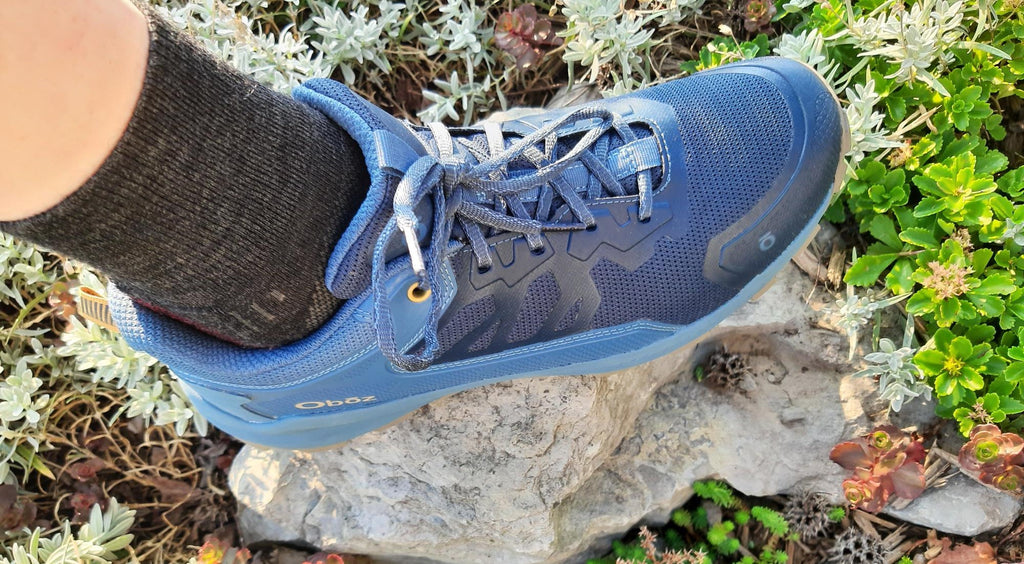
Oboz Katabatic Review
OBOZ KATABATIC LOW
So....You’re looking for a pair shoes. Looking for something that has a bit more utility for the everyday world? On and off the trail? Then perhaps the OBOZ Katabatic Lows are the footwear you have been looking for.
WHAT ARE THEY?
Well, they're a low cut fully synthetic hiking shoes. Lightweight and more breathable than your standard leather hiker. They come in both a waterproof and non-waterproof version, but we will be specifically looking at the non-waterproof version today. Being a lightweight synthetic shoe will obviously give you weight savings over a regular leather low hiker. To put these on your feet you might be surprised at just how light they actually feel once they are on your feet. I mean we all know the substantial difference in weight when you switch from your mid or high cut boots to a low cut. Put a pair of Katabatic Lows on though, and they're just that much lighter feeling compared to other low cuts. It almost feels like you have the weight of a pair sandals on instead of a full pair of shoes.
Above and beyond the weight savings is the breathability. Much airier than a leather or leather/synthetic mix of a shoe, it makes it a very good shoe for the summer months or warmer areas. I find the non-waterproof ones personally better than the waterproof ones. Being a low cut, in all likelihood you’ll eventually go over the top of the shoe in wet conditions or locations and I can treat them for good water repellency. If I end up dunking my feet, they dry in very little time, and if I get them filthy they'll clean up and dry easily.
THE FIT
Fit is always important. So how do they fit?
Over the years I have tried and worn many different brands of synthetic hiking shoes; Vasque, Garmont, Merrell, Salomon and more. The Salomon X-ultras were lightweight shoes, and I worked my way through many a pair over the years until my foot and fit changed. I find the Oboz even lighter on the feet than the Salomons. As my feet started to flatten out and widen, the shoes I had been previously wearing had now begun to pinch and feel tighter on my baby toes and the outside of my forefoot. The Oboz Katabatic has a slower taper going toward the outside of the forefoot offering me more room for the widest part of my foot. The Katabatic and a good majority of the Men's Oboz footwear have this fit as well. For those who need a wider fit, some models are offered in wide fit as well. I still cannot wear Merrell and KEEN hiking shoes as I find my heel slides around in those brands even when wearing the proper hiking sock. The Oboz has a nice deep heel pocket, and with a proper hiking sock they anchor my feet in the heel very well and reduce the amount of movement and the chance of blisters. The fit of the Oboz doesn’t necessarily mean that if you're a long term Merrell or KEEN fan that you won't find it comfortable too. I've helped many a long-time faithful of those brands comfortably switch to wearing Oboz and become repeat buyers like myself. Keep in mind fit is such a personal thing, so these are just my observations. When trying shoes on for yourself, remember a proper sock can make a world of difference.
THE PERFORMANCE
The Katabatic Lows offer a very sturdy stable shoe with a very comfortable cushioned feel. Well-structured for the trails, I have worn mine in varying conditions; dry, rocky, uneven, wet and muddy. They offer good traction to go with the support. The outsole tread is aggressive enough for most conditions for a light trail excursion, and I find it doesn’t clog up in muddy conditions as easily as some other tread patterns.
Oboz most popular low-cut has always been the Sawtooth, so how does the Katabatic stack up? The Sawtooth’s are a much more solid hiker, with a step up in structure, support and tread pattern. With that being said, I find the Sawtooth is too stiff and structured for everyday wear on concrete and asphalt. The Katabatic on the other hand is not. As I mentioned before, they are a lighter trail shoe by design. I’m not only referring to the weight though, the outsole is a good firm tread, but a bit more of a pliable compound. To go with that the midsole is firm but softer than a Sawtooth, with a spongy, cushy feel to it that I find lessens the wear and tear on my feet and lower body.
So, if you're looking for a good trail shoe, or a good everyday shoe, or simply one with a good fit and comfort, then the Oboz Katabatic may be your shoe. Grab a pair and try them on, and if they work for you then and hit the trails, or the sidewalks, or anywhere!
Reviewed by BR

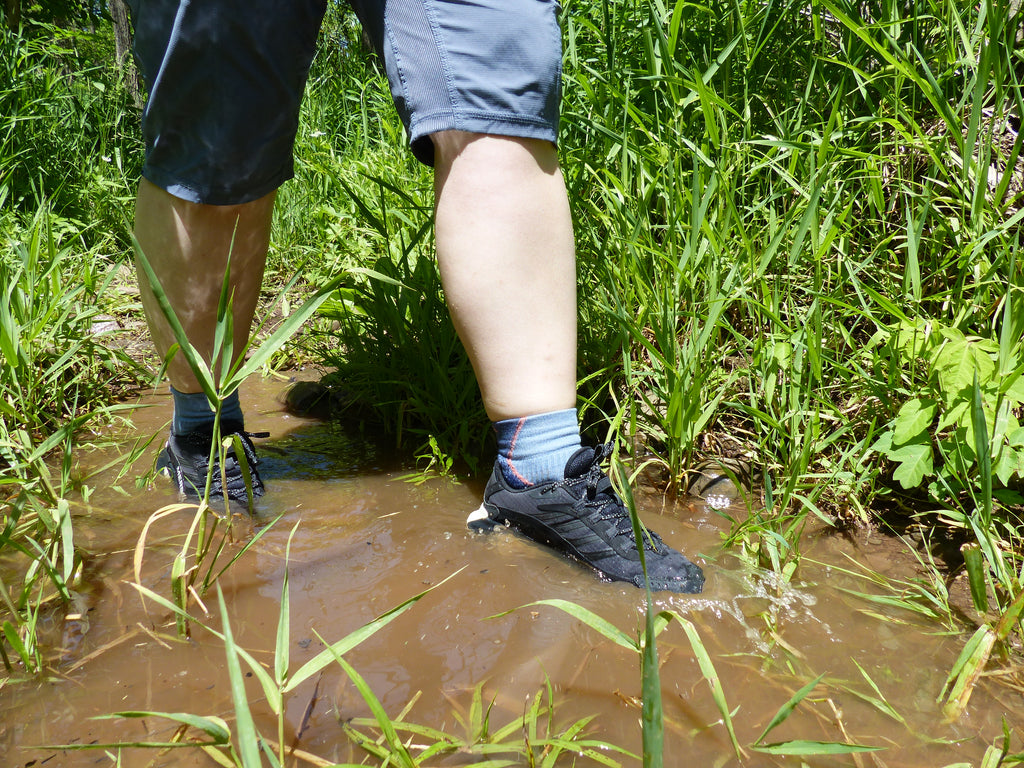
Merrell Moab Speed 2 GTX Review

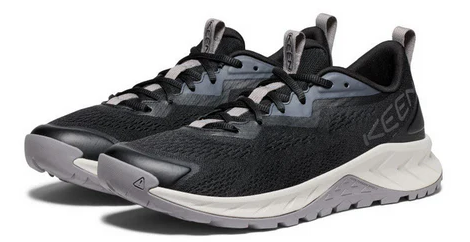
KEEN Versacore Review
The KEEN Versacore Speed is a light, comfortable, wide trail runner.
First thing to know about the Versacore Speed is that KEEN has managed to make a shoe that holds true to their wide toe box that they’re known for in hikers (like the Targhee II and IV) with aesthetics more reminiscent of common running shoes. The fit on these shoes sits wide, with ample room in the toe box for even the widest feet, while the mid and heel of the shoes manage to narrow down and hold the foot firmly in place.
Underfoot, the Versacore Speed offers a solid and rigid structure sitting atop a layer of soft foam. This provides cushion for those that need it when walking on hard surfaces like concrete, rock, or hard packed earth, while preventing aches and pain that can be found while wearing hard soled heavy hiking boots. The rigidity under foot meant that pronation was effectively not felt, even on rough or uneven terrain.
A light mesh upper allows for breathability and a small amount of give when lacing up, helping to improve fit-to-foot. The tongue on the Versacore Speed is not sewn along the sides like some modern shoes meaning that those with high volume feet have a bit of extra room to slide in when putting them on.
The lug on the sole gave reasonable grip without being excessively deep. Their mild rise meant that when dealing with puddles and shallow water they prevented the feet from becoming soaked. On the few occasions that the shoes were used in enough rain to become soaked, the light breathable upper allowed them to dry quickly enough that usually a change (or two) of socks after the rain was enough to have dry feet again.
Reviewers Note: When wearing for long periods of time the lateral section of the foot (outside, opposite the arches) ached. After trying multiple pairs this has not been a consistent issue with all shoes but I would recommend any potential buyer test the shoes indoors before attempting to take them out.
Recommended use: The Versacore Speed excels as a light trail hiker/runner with the design appearing to focus more on hiking/walking, than as a dedicated trail runner. With the rigid sole, the Versacore Speed also functions reasonably well as a trainer/exercise shoe, and combined with its Keen.All-Terrain lug sole it means you have a shoe for on trail fitness, or even a Tough Mudder regardless of the weather.
Who this shoe is recommended for:
- Hikers
- Dog walkers
- Casual trail runners

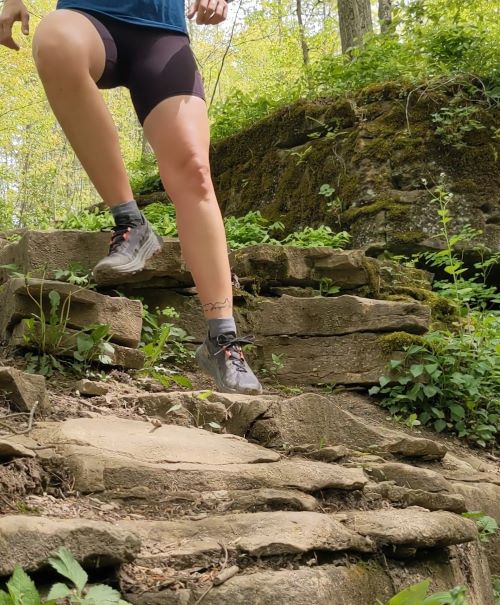
La Sportiva Prodigio Staff Review
La Sportiva Prodigio Review by Laura from Outdoors Oriented
I've put >50k on these so far and loving them! Here's a little rundown on my experience so far.
Fit and Features
- This is a cushioned shoe that strikes a good balance between comfortable cushion, energy return and stability. The cushion is soft but has some bounce to it, which is a good thing (propels you into the next stride a bit.) What I really like is that it has a max-cushion feel without being too high off the ground and thus unstable like some shoes (Hokas.) It's also not too stiff and retains good ground feel, which some cushioned shoes really lack.
- Outsole is great. The lugs aren't overly deep (which is good on flat, non technical surfaces like paths or hard dirt trails) but they are well designed to maximize grip. The outsole material (Frixion Red, ironically the black portion of the outsole) is nice and sticky while being more durable than the Frixion White which we saw on the Ultra Raptor. The outer edges of the heel area are made of a more durable compound to resist wear. The shoe performs well on a variety of surfaces - dirt, light mud, wet grass, rock, roots, wooden bridges. Grip on rocks was especially secure. There is a flexible laminated nylon inlay in the sole that functions as a rock plate to protect your foot from sharp rocks and other debris.
- More generous fit than other La Sportiva trail shoes. Not necessarily overly wide in the toe box, just fairly roomy all around without being sloppy. The Bushido has a more precise fit and is all-around a more technical shoe, but with less cushioning. (In my opinion, and for my weird feet) this is a roomier shoe than the Oboz Katabatic, KEEN Zionic and La Sportiva Bushido, reasonably on par with the KEEN Versacore and Merrell Agility Peak. As with many La Sportiva shoes I find that I need to size up a half size from my usual.
- Highly breathable mesh upper doesn't get hot, drains and dries quickly when wet.
- 6mm drop - Lower drops take stress off the knees but place it more on the calves and Achilles. For those looking for that, this is a good offering.

Who should try on this shoe?
- Trail runners, obviously!
- Those who have been looking at/having been recommended Hokas or similarly cushioned shoes.
- Those who like the idea of a light, fast-drying, all-rounder shoe.
- Those who hike long distances. This would be a super comfy shoe for long day hikes.
- Those who will be hiking in areas that are fairly technical with lots of rock (Bruce Peninsula, Killarney, out west) as these puppies are pretty great on exposed rock. Even running at speed downhill I was never unsure of my foot placement on rocks and always stuck like velcro.
Maybe not ideal for:
- Those who want firm cushion or a lot of arch support. An alternative in this case would be the Merrell Moab Speed (Men's Women's) as it has both those things if you still want a lighter shoe.
- Backpacking with a heavy pack - though this is a matter of preference and lots of folks thru hike in trail runners - the soft cushion of these shoes wouldn't be as ideal in my opinion for heavy weight carrying.
- Those who are doing a lot of pavement/road walking, like the Camino, for example - the rubber compound isn't intended for this and will wear more quickly. The Merrell Morphlite Men's Women's for a light shoe or the new KEEN Targhees or Oboz Sawtooth X would be better for this.
- Snowy conditions
Other similar models offered by Outdoors Oriented:
Merrell Agility Peak Men's Women's, KEEN Versacore Men's Women's, La Sportiva Bushido Men's (though fit is a bit different)
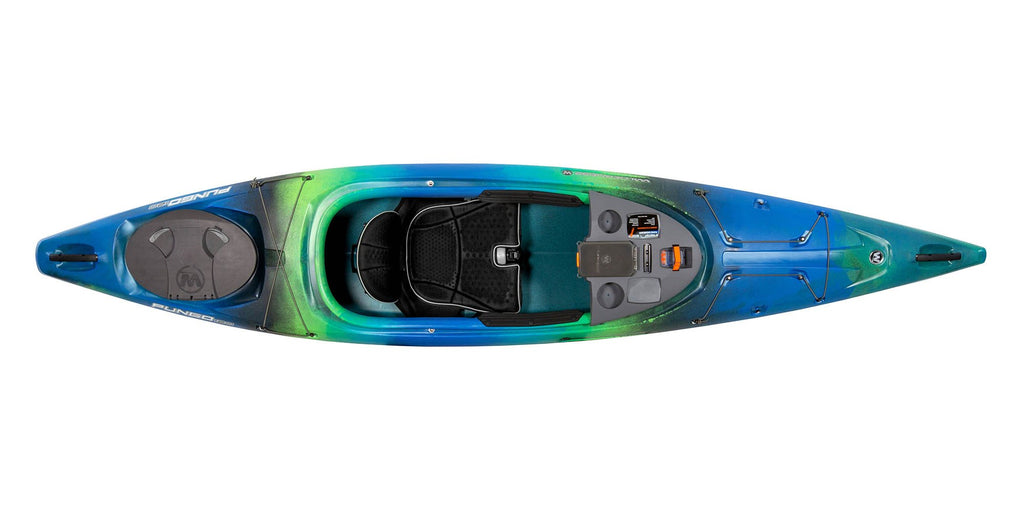
How do you improve upon a legend? The 2019 Wilderness Systems Pungo
"Don't mess with a good thing"
"How do you improve on perfection?"
"If it 'aint broke don't fix it"
All these sayings were no doubt weighing on Wilderness Systems designer's minds for many years when dealing with how to update the legendary Pungo. This is not just another kayak model. This is THE best selling recreational kayak model of all-time, and it didn't get there by accident. The Pungo series has always been the perfect blend of stability, speed, maneuverability and comfort. Other kayak manufacturers have always set their sights on building a better Pungo, and although some great designs have come along over the years, the Pungo has always been a step ahead. For 2019 the redesign was finally ready and we're excited that it's still a Pungo at heart, but with some great new features that should keep it at the top of every recreational kayaker's list.
What's changed?
- New sizes - The Pungo series has always had multiple sizes, but the most popular size has always been the 12' version. For the 2019 version, the 12' size has been split into a "120" and a "125" This offers a more appropriate fit for every body type. Small and medium size paddlers will find the 120 to fit more comfortably, while larger paddlers will appreciate a roomier fit in the 125 due to increased deck height and a slightly larger cockpit. There's also a shorter version available in the "105" which has all the same features, just a few feet shorter.
- New Dashboard - This removable console has always been a great feature of the Pungo, but the 2019 version has seen some major upgrades. It now features a removable drybox, two cupholders, and slidetrax rails that will accept accessories like fishing rod holders, or phone mounts. It also has a recess that will allow the Wilderness Systems lithium battery (sold separately) to be mounted to keep all your electronics charged up.
- New Deck Rigging Configuration - The deck rigging on the bow has changed and now allows paddlers to add specifically designed matching deck pouches (sold separately)

What's stayed the same?
- The hull shape - This is very similar to versions before and is a big part of what has helped the Pungo become so popular. The hull offers a great blend of stability, speed and straight line tracking.
- Phase 3 AirPro Seat - Arguably the most comfortable sit-inside kayak seat available. It offers lots of adjustment and all-day comfort.

- Hinged rear hatch cover - Super quick and easy to get in and out of, and a large opening that accommodates large drybags.
We certainly think Wilderness Systems hit it out of the park with the redesign of the Pungo and we'd love to show you one in person. Stop by the shop to check one out!

Which pack would you live out of?
Comparing the Osprey Farpoint/Fairview Series to the Ozone Duplex
The challenge of fitting your entire life in a bag for the next little while can seem quite intimidating. For some occasional travelers, plain jane luggage will do the trick, but for those avid globetrotters jumping from hostel to hostel over the period of days, weeks or months (maybe even years!), luggage literally becomes a home, and therefore becomes an investment.
When shopping around for that investment, we tend to be on the lookout for convenience, comfort and organization; and we’d be lying if we didn’t say we’d want it to look decent too, ma’ right?! There’s a long list of backpacks out there we could throw at you that would check off that list, but we want to focus primarily on Osprey packs for this article.
When it comes to Osprey travel packs, you´ve got two major options for backpacking light. The Farpoint/Fairview series and the Ozone Duplex. These two bags are similar, yet designed for two very different types of backpackers. We’ll break down each backpack for you in this article so you can see which backpack may suit your style best.
The Farpoint/Fairview series

Although The Farpoint (men’s version) and the Fairview (women’s version) are identical when it comes to organization and layout, there are a few minor details we’ll focus on right away. The Farpoint is available in Volcanic Grey and Jasper Red, and the Fairview is available in Rainforest Green and Misty Grey. Both genders come in a 40L, 55L and a 70L and the Farpoint comes in an additional 80L size. The Farpoint torso sizing is available in S/M and M/L, and the Fairview comes in XS/S and S/M. When considering torso sizing, keep in mind that the actual litres of the bag may change slightly between torso sizes and genders. For example, the Fairview 40 XS/S is actually 38L compared to the Fairview 40 S/M is actually 40L.
The Farpoint/Fairview series bags incorporate an aluminum frame to prevent your bag from sagging and helps make sure all that weight stays off your shoulders and makes its way to your hips. These bags still incorporate a great harness that we all know and love from other Osprey hiking and expedition bags. Nice broad and comfy hip straps, adjustable sternum strap with whistle and conjoined shoulder straps with a “yolk” at the neck. The entire strap system also conveniently stows away in an easily accessible zippered flap. Whether using the stowaway feature on the carry-on 40L bags or checking the larger 55L, 70L or 80L bags, the straps are safely out of harm’s way during your travel.
The main compartment of the Farpoint/Fairview is a large luggage style opening allowing maximum accessibility. It also features two compression straps to keep your items compact and secure while traveling.

The secondary compartment on the 40L and 80L include a laptop sleeve and a large pocket for your toiletry and other organizers. The exterior of the bag also features a hidden slash pocket for quickly accessing your phone, wallet, passport etc., two deep mesh water bottle pockets and two compression straps to keep your whole bag as small and secure as possible. As for the 55L and 70L Farpoint and Fairview, the secondary compartment is detachable and conveniently becomes a daypack and/or carry-on.
When it comes to the detachable daypack on the 55L and 70L bags, the straps and structure of the bag are fairly basic. This removable daypack is simply to throw over your shoulders for an urban adventure or those light hikes with minimal weight.
In comes the Ozone Duplex

This bag comes in a black 65L (men’s version) and in a blue 60L (women’s version). Although the Ozone Duplex is limited in selection of size, when split into its two pieces, both the 60L and 65L are carry-on compliant! Imagine that, up to 65L of carry-on space. This bag features a similar harness system as the Farpoint/Fairview, but it doesn’t stow away since typically you'll be carrying this instead of checking it. Rather than having varying sizes in torso length, the Ozone Duplex features an adjustable torso height for a more accurate fit. The Ozone Duplex can easily be compared to the Farpoint/Fairview 55 and 70, as they both have a removable daypack. Where the main difference comes in, is the daypack itself.

Right off the bat, you’ll notice that the primary compartment of the Ozone Duplex is located on the outside of the bag. This compartment is accessible by a large U shaped luggage flap. The Duplex still features compression straps on the interior of the primary compartment, but Osprey decided to modify them slightly by adding more material to keep your items more secure.
Now, compared to the Farpoint/Fairview 55 and 70, where the daypack is removable from the main, larger bag, and features its own additional straps, the main storage compartment on the Ozone Duplex is actually removable from the daypack. The Ozone Duplex was designed with a comfortable and technical daypack in mind. The main strap system and aluminum wire frame is actually part of the daypack itself. This daypack is meant to carry much more weight than the daypack on the Farpoint/Fairview 55 and 70. This secondary compartment and removable daypack features a hidden slash pocket behind the harness near your head, a large laptop sleeve with organization behind the straps on your back and a large opening for larger items in its main zippered compartment.
To sum it all up, both these bags each have their own unique features for their own unique travelers. The Farpoint/Fairview series can be preferred by the urban travelers, where the variety in liter sizes and a simple, lightweight daypack is more favorable for a day in the city or those light treks to a nearby waterfall. As for the Ozone Duplex, this bag may be preferred by those globetrotters who frequently do longer day trips where comfort and weight distribution is more critical.
But rest assured, whichever your decision, the quality and craftsmanship of Osprey products along with their lifetime warranty is second to none.
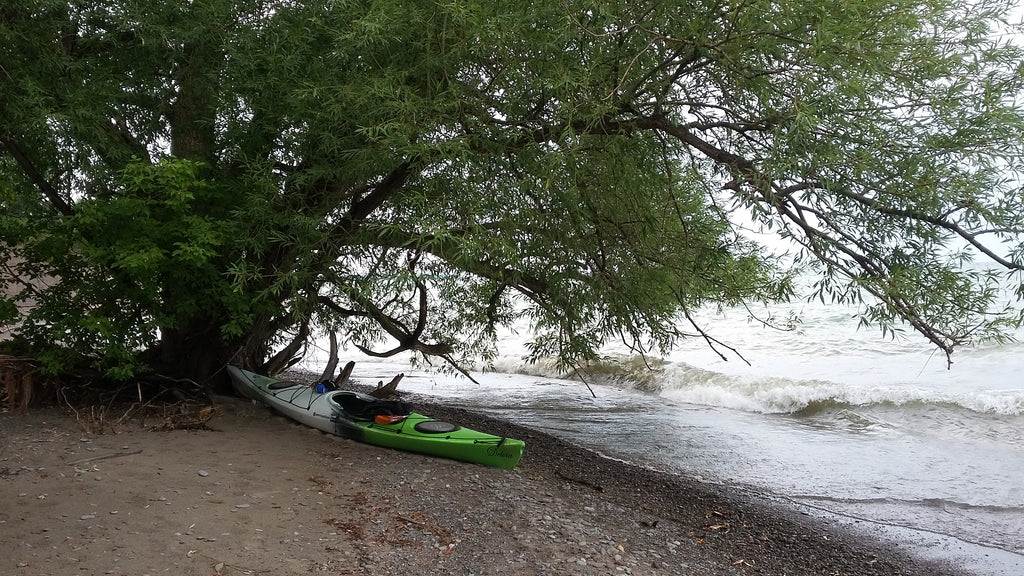
Kayaking Niagara: Always Be Prepared
Kayaking Niagara: Always Be Prepared
By James Ryan
“Survival was my only hope, success my only revenge.” – Patricia Cornwell
As I sheltered myself from the impending thunderstorm, tucked beneath the branches of a big 'ol hickory tree located somewhere along the rocky shoreline of Lake Ontario, I knew right then and there that getting myself off of the water when I did was the only smart thing that I had done all day. Up until that point, I exercised some pretty poor judgment at just about every opportunity. Good thing I learn from my mistakes.
Here's what I did wrong (for your benefit) and what I should have done differently (for mine):
1. A few hours before I headed out to go kayaking, I checked on the status of Lake Ontario, only to find out that it was relatively calm and flat. In hindsight, I should have checked again before I left the house, as a few hours had passed by since my original inquiry. Something else that I should have done (and always do) is check the local weather report, but since the weather predictors rarely get it right anyway, I decided not to bother. Those were my first two mistakes.
Lesson 1: Always check the weather forecast, especially when you're going out on a larger body of water.
2. I stepped outside where despite the instant humidity, I noticed that the sun was hidden by some slightly ominous clouds up above. Is it gonna rain? I wondered. After driving down to my launching point, I then made a few critical errors in judgement, which ended up affecting me for the whole remainder of the day. For starters, I placed my QikPac rain jacket into my deck bag, only to hesitate and immediately remove it, as I felt fairly confident (wishful thinking) that it wasn't going to rain. In fact, I was so convinced, I also decided to leave both my Tilley hat and my t-shirt behind in the truck, which looking back, is something that I NEVER do. From the moment that I stepped out of the house, I had a gut feeling it could rain, but for some reason, I ignored my initial instincts.
Lesson 2: Always pack a drybag with extra clothes, rain gear, food, etc. because... well... you just never know.
Lesson 3: If you get a sense about something weather-related, listen to your instincts, even if it seems unlikely. Better safe than sorry.
3. Thunder and lightning seem like pretty good indicators that the weather's about to go sideways in a hurry. Lake Ontario was calm, yes (as per my lake report), but on the opposite side over by Toronto, the sky was dark and stormy. I immediately saw lightning, so I stopped, considered going back, but assessed that the southern-directed wind was pushing away from shore, which in my mind meant that the storm was moving further North, not South. I decided to go for it as there were plenty of other watercraft out on the lake. Maybe they knew something I didn't?
Lesson 4: If you see lightning, get off the water, as the wind can change at a moment's notice.
4. Keeping a close eye on the storm as it ripped its way over the northern part of the lake, I eventually noticed a slight shift in wind direction, which was now blowing from directly behind me. I quickly turned and noticed a new set of storm clouds making their way in my general direction. They weren't there a couple minutes ago, I thought. Again, I debated on turning around as the breakwalls in that area would have made landing on shore far too dangerous (I also forgot my helmet), but figured I'd run straight into the storm if I did. Instead, I opted to go to a little beach that I knew of about 10 minutes up the shore where I figured I could land at. With the wind and the waves at my back, I hoped I could make it in time. The race was on!
Lesson 5: Don't mess with Mother Nature. She's faster than you.
5. The sky began to spit down when I was only about a minute away from my secured destination. A couple of girls who had been sun-bathing, immediately packed up their stuff just as I landed on the beach. With little time to spare, I quickly assessed my surroundings for the safest (and driest) possible shelter. I dragged Delvia (my 15-foot Perception kayak) up to the base of a tree and took cover under the enormous canopy of leaves. That's when the wind, waves, rain and lightning all began to pick up.
Lesson 6: Never sit under a tree during a lightning storm. Pretty sure I learned that one as a kid. Duh!
6. As the rain poured down, the temperature quickly dropped around 15-degrees in a matter of seconds. I was freezing. Why didn't I at least bring my t-shirt? I thought. With no other clothing options to keep me warm, I removed my spray skirt, draped it over my head and shoulders, and sat on Delvia's top side under the protection of the tree's leafy shelter. I remember looking out into the lake as the torrential rain began to fall, observing a dozen or so birds all perched together on a large rock not far off-shore, thinking to myself that the storm might not be that bad after all. If they can tough it out, I thought, so can I. Two minutes later, they were gone. Dagnabbit! Lesson 7: What doesn't kill you, makes you stronger.
Long story short, the storm passed by, I lived to tell the tale, and I vowed never to go kayaking again without a dry-bag full of what I would consider to be the basic essentials. Here's a list of what they are in case anyone out there's curious and would like to follow suit. Also, please feel free to customize it however you'd like depending on your personal tastes or even the time of year (winter kayaking for example is a whole other ball game).
[Shown in photo, from left to right]
- Petzl headlamp (extra batteries also recommended)
- Wind/Waterproof storm matches
- Flint striker (for starting fires)
- Sweatshirt (wool or synthetic preferred over cotton)
- Small medical/first-aid kit
- 100 ft. of paracord rope
- Small pack towel
- Fire starter/tinder (UST Wetfire recommended)
- Emergency blanket/tarp
- Qikpac rain jacket and pants
- Bug spray
- Toilet tissue and trowel (for when nature calls)
- Merino wool baselayer shirt/pants, socks, and toque
- Lifestraw water filter
- High-visibility BUFF
- Mitts (not gloves)
[Not shown in photo, as it's a given you should have these items anyway]
- Rescue knife
- Compass
- Sunglasses
- Safety kit (whistle, rope, and bailer)
- Small signal mirror (optional)
- Hat
- Wide-mouth water bottle (Nalgene)
- Life jacket
- Energy bars/snacks
- A book (in case you're stranded for a while)
- Cell phone/camera (in a waterproof case)
- Spare paddle
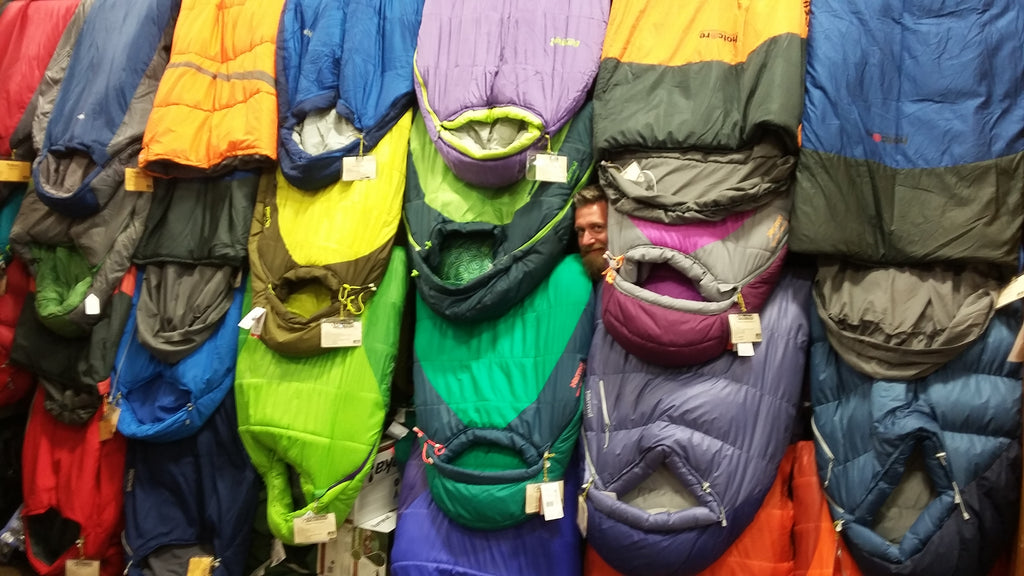
How (and Where) to Buy a Sleeping Bag
How (and Where) to Buy a Sleeping Bag
By James Ryan
Whenever I'm asked about sleeping bags from would-be campers, I'm often reminded of a time in my life when I knew very little about wilderness camping. One memory in particular that comes to mind would be from late-August of 2007 when I decided to take my 10-year old son up to Algonquin Provincial Park on what would’ve been our second annual father-son canoe trip. All I can say is that it was without a doubt one of the most uncomfortable, albeit memorable, experiences of my entire life.
[I even lost part of my finger on that trip, but that's another story for another time.]
Despite being warm and sunny throughout the day, the evening temperatures had dropped down to near freezing, which was surprisingly uncharacteristic for that time of year. Unfortunately, it hadn't even occurred to me to check the weather forecast for the over-nights or to even bring what I would consider to be cold-weather clothing. The day predictions were so hot, that that’s all I really paid attention to – rookie mistake!
Another unpleasant revelation that evening was that our cheap, department-store sleeping bags were clearly no match for the cold night air, so we were forced to wear all of our available clothing (even the dirty stuff) which we packed for the entire trip, but it still wasn’t good enough. As it turns out, cotton is not a very good heat insulator, especially if you’ve been sweating in it all day long. We got very little sleep on that trip, and by the end of it all, I had the worst sore back imaginable.
Being a young dad with two athletic kids to look after, I didn't have a lot of disposable income at the time to spend on quality camping gear, so I did what most people would have probably done in my situation and cheaped out, figuring that all camping gear was pretty much the same. Well, I figured wrong.
In hindsight, if there was one piece of camping equipment that could have easily transformed our entire adventure and made things far more enjoyable for the both of us, it would have been to have high-quality sleeping bags. Back-country camping is most certainly a working vacation, therefore, getting a good night’s sleep is always a top priority.
So what should you look for in a quality bag? For starters, it's good to ask yourself the following questions:
• What style of bag are you looking for?
• What time of year do you plan to go camping?
• What type of insulation do you want?
The style of bag you choose can make a huge difference in terms of overall warmth. The rectangular bag for example, is exactly as it sounds – a big 'ol rectangle. It provides a lot of extra room (less restrictive), particularly in the footbox area, which personally I prefer. And if you plan on zipping two bags together for snuggle-time with your significant other, then you can't beat a rectangle, which also turns into a much larger square, with the zippers all located on the outside edges. Next to freezing your butt off, there's nothing more annoying than sleeping on a zipper.
The mummy bags on the other hand, are the most thermally efficient bags on the market, as their snug-fitting design creates less dead-air space, and provides an insulated hood area for added warmth. They also typically pack smaller and lighter when compared to an equivalent rectangular bag. Some mummy bags can also be zipped together, but due to their shape, only connect in the middle sections, leaving the footboxes separate from each other, and the zipper running down the centre between two would-be snugglers.
The second most important consideration when buying a sleeping bag would be the time of year that you plan on going camping. In Canada, for example, where we deal with fairly drastic weather changes between the summer and winter months, it's important to decide WHEN you plan on spending most of your time outdoors.
- If you only plan on winter camping, then you definitely want a warmer-rated bag (-10°/-30°).
- If you only plan on summer camping, then you definitely want something that's better suited for the warmer climates (+7°/0°).
- If you plan on camping anytime during the year from spring thru fall, then you may want to consider something a little warmer, with the idea that if it gets too warm during the summer months, you can always kick it off a little bit (+1°/-7°).
- If you plan on camping all year-round, then I highly suggest buying two separate bags or you'll run the risk of either over-heating in the warmer months, or freezing to death (literally) in the colder ones. Please also note that some companies (Marmot, for example) also make lady-specific sleeping bags, which provide added insulation around the common cold spots, such as the footbox and the torso area. They also fit a bit shorter than the guy’s version, so that's just something to be aware of.
Please note: The temperature (EN) ratings presume that the user will be sleeping on a minimum 1-inch thick sleeping pad with an R-rating of 3 or more. Sleeping bag ratings can also be influenced by the following factors:
- gender
- body fat percentage
- muscle mass
- circulation
- metabolism
- shelter
- wind
- exhaustion
- clothing
- nutrition
The final most important consideration when buying a sleeping bag is the fill. For the longest time, down insulation had been the preferred choice for many campers because of its heat-insulating properties. Synthetics on the other hand, have come a long way in the past few years, and many would argue, do just as good a job as down-filled sleeping bags. For me, the biggest difference between them relates to damp conditions. If a synthetic bag gets wet for any reason, it will still retain its warmth, and it will also dry a lot quicker than down will, which tends to stay soggy for a longer period of time.
When purchasing a new sleeping bag, keep in mind that you generally get what you pay for. Bags that are cheaply made for example, will not provide the same level of warmth or durability as a quality sleeping bag from a reputable brand found mainly at specialty outdoor shops. By comparison, better quality sleeping bags typically have baffled construction to keep the insulation from shifting or clumping, which ultimately helps to keep any potential heat loss to a minimum.
Additional Sleeping Bag Terminology
- Anatomical Hood: Insulated, prevent heat loss, increased comfort and thermal efficiency.
- Baffle: Seems in the shell to keep insulation from shifting or clumping, keep heat loss to a minimum.
- Draft Collar: Aka “Headgasket” is an insulated collar around the hood, stops heat from escaping.
- Draft Tube: Insulated tube runs along and behind the zipper to stop cold drafts from getting in and warm air from getting out.
- Drawcord Collar: Tightens and loosens the hood to prevent heat loss.
- Footbox: A trapezoidal or flared footbox allows for more space.
- Lining: Interior, soft and comfortable, moisture-wicking technology.
- Shell: Exterior, more durable than interior, water-resistant.
- Stash Pockets: Chest pocket for phone/music.
To check out our selection of quality sleeping bags click HERE
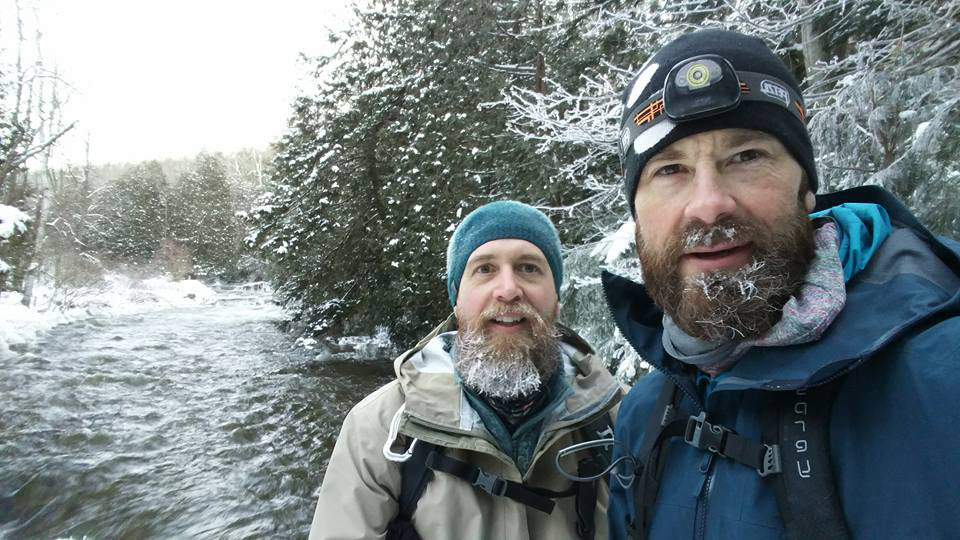
Why Merino Wool is Superior to Synthetics
By James Ryan
“People are usually more convinced by reasons they discovered themselves, than by those found by others.” – Blaise Pascal
The first time I ever heard about merino wool, I was on an overnight hiking adventure during a typically cold February evening in minus 20-degree weather. My trail partner, Jonathan, who by 4am had already been hiking for close to 20 straight hours, was layered in merino wool from top to bottom. Although he was understandably tired from his physical efforts, he was seemingly quite comfortable and unaffected by the blistering cold temperatures that surrounded us.
I, on the other hand, had not properly prepared myself for the arduous 12-hour hike that was ahead of me. My synthetic long underwear, which had served its purpose for so many years prior in less extreme conditions was performing as well as always, but still nowhere near the level that my hiking companion was experiencing. Truth of the matter is; I had no idea what I was missing out on.
“Man, I’m freezing,” I told him, as we trekked along the snow-covered highway, wind and snow whipping into our faces.
“What are you wearing?” he asked.
“Why, what are you wearing?” I inquired back.
Personally, I was wearing a synthetic base-layer, a cotton t-shirt, a long-sleeve cotton shirt, a non-breathable fleece sweatshirt (in hindsight, not the best choice), and my trusty wind-proof, non-insulated QIKPAK™ rain jacket. I hadn’t initially planned to go hiking that night, but in fairness, I did think that I had prepared well-enough for the cold weather from the safe interior of the support vehicle, which no doubt I would have been. Hiking at all hours of the night however, proved to be an entirely different challenge.
Read: Jonathan’s Hike to Defeat Depression – Live at Five!
Jonathan, on the other hand, was toasty-warm in nothing more than his merino wool base-layer, a merino wool mid-layer top, and a lightweight GORE-TEX® jacket and pants. He also had merino wool socks and a woolen hat. I was amazed that he was handling the cold so much better than myself in what seemed like half the amount of clothing.
Another problem that I experienced that night was the constant overheating. One of our first hurdles was a long, steep climb up to the top of the Beaver Valley Ski Resort along the Bruce Trail. Half-way up the climb, I had to strip off both my jacket and my sweatshirt. Perspiration had completely soaked my entire back from where my backpack was resting, leaving myself open to the unforgiving wintery elements. By the time we got up to the top and out of the shelter of the wooded trail, the wind immediately cut through my drenched upper layers. Whatever body heat I had at that point was now long gone. I tossed my sweatshirt and jacket over my cold, sweat-filled layers of synthetic and cotton fabrics, and proceeded to suffer for the entire remainder of the evening as they never did dry out completely and they certainly never warmed up.
The next day, as I was recovering from my hellish experience, I decided to do a little research. What was merino wool exactly? How did it work? Why was it out-performing my synthetic long-johns by such leaps and bounds? But also, how did it differ from regular wool? – you know… those socks we had as kids that made our feet sweat and stink and itch like crazy, but looked much cooler with a nice pair of hiking boots than ordinary white cotton socks, so we wore them anyway. And don’t even get me started on those insane sweaters that you’d swear were made from discarded old Brillo pads.
What I proceeded to learn reminded me of the old saying: “If it sounds too good to be true, it usually is.” The more I read about merino wool, the more it was sounding like some made-up miracle fabric, concocted by someone who I imagined was a young, ambitious marketing executive.
So let me get this straight, I thought. Merino wool, because of its origins in New Zealand where the sheep live in extreme climate changes throughout the entire year, keeps me cool in the summer and warm in the winter? It self-regulates my body temperature? It wicks moisture AND resists odor? It dries quicker than synthetic and it uses 100% all-natural, soft fibers? – no plastics or other dangerously flammable or toxic materials next to my skin?
My next question was; how can such a material, particularly a natural one, even exist? It just didn’t make any sense to me. If it was so great, then how was it possible that I had never even heard of it before?
Oh, and best of all… apparently when it gets wet (from sweat for example), merino wool still retains body heat and keeps you warm in cold weather while it dries out quickly and naturally. No way! I thought, once again thinking of those old itchy socks from yesteryear.
Then I got to thinking about my predicament at the top of Beaver Valley and how Jonathan didn’t seem to be experiencing the same level of discomfort as I was. I was also thinking about how halfway through the hike, my synthetic socks were completely soaked right through, causing my feet to freeze up and blister on the outsides of my pinky toes and where my Achilles rubbed up against my boot. There had to be a reason and all solutions were pointing to merino wool.
Knowing that I had another 12-hour hike scheduled for the following weekend, I figured I had nothing to lose and everything to gain by trying it out for myself, so I went for it, and let me tell you… I’m extremely glad that I did.
To this day, my merino wool purchase has been one of the best investments that I have ever made. That following week, I was forced to deal with colder temperatures, deeper snow and rougher terrain, but other things that I didn’t have to deal with included: overheating, extreme heat loss, soaked feet, and a drenched, freezing back.
Reading about merino wool is one thing, but I learned that trying it out for yourself is quite another. But hey, don’t take my word for it… take a leap of faith and give it a try. I genuinely and sincerely believe that you won’t be disappointed. I know I wasn’t. Cheers!
-
RESILIENCE
Merino wool fiber has very good extensibility and can be extended by more than 30% of its length without breaking. It also has an intrinsic wavelike structure called crimp, making it more resilient. -
THERMO REGULATION
Merino is a technically active fiber, which has the ability to gain and release heat depending on the wearer’s next-to-skin environment and external conditions. As merino absorbs moisture, it releases a small amount of heat, and in hot conditions, the reverse effect occurs. -
SOFTNESS
Fine fibers from sheep such as merino, are comfortable and soft enough to be worn next to the skin. -
ODOR SUPPRESSION
Merino outperforms other fibers with its ability to resist the build-up of unpleasant odors. Odor molecules are absorbed into the merino fiber, effectively becoming trapped and less readily detected by the human nose. -
UV PROTECTION
Merino naturally protects from UVA and UVB rays without extra fabric treatment. This makes it the perfect fabric to wear in summer. -
BIODEGRADATION
Many textiles are made from materials that do not biodegrade. Merino wool is a naturally biodegradable fiber where under the right conditions, merino will readily biodegrade when buried in soil. Synthetic materials will not and can remain in the environment for many years. -
MOISTURE MANAGEMENT
The merino fiber can actively manage moisture by absorbing from the skin and then desorbing to the atmosphere, leaving you dryer and more comfortable. A merino fiber will absorb up to 35% of its own weight in water before feeling wet – much greater than most synthetic fibers. -
FLAMMABILITY
Merino is naturally flame resistant, and its performance exceeds that of all other commonly encountered textile fibers. If merino comes into direct contact with another burning surface, it won’t melt or stick.
Incredible!
Source: https://ca.icebreaker.com/en/our-story/natures-performance-fiber.html
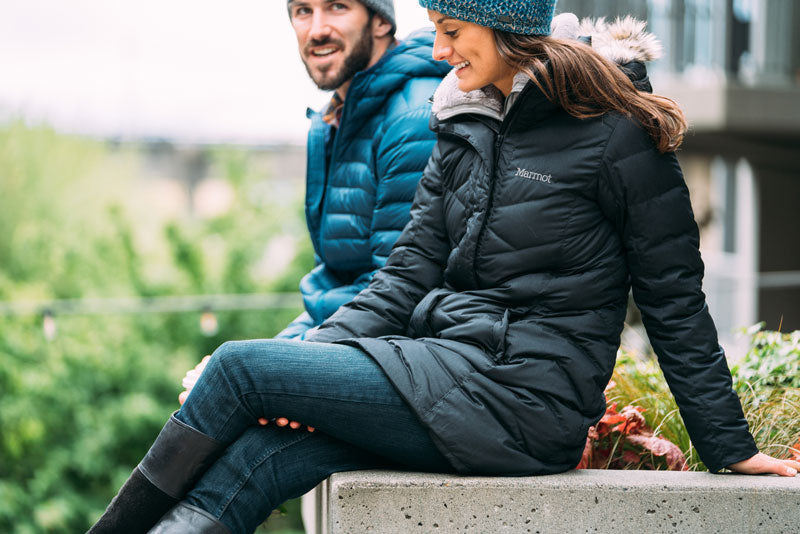
The only guarantees in life are death and taxes...AND WINTER!
Benjamin Franklin was once quoted as saying “ The only guarantees in life are death and taxes”; as Canadians I think we can safely add winter to that list. That being said with winter temperatures and snow in our near future we need to talk temperature ratings on coats and boots and how there are no guarantees. It is silly to think that just because a boot or coat “is good to -20’C” that that will be true for everyone. Activity, tendencies and layers all contribute to the warmth of any given item.
For winter apparel follow these 3 simple rules and you will be warm and dry until the spring crocuses pop through that final bit of snow:
Rule #1 - You are the furnace, your coat and/or boots act as the insulation. So, if you tend to be a colder person or are not producing heat (ie: standing waiting for public transportation) you will need the most insulation possible to trap what little heat you are producing. On the flip side if you run hot (either just someone who runs on the warmer side or are literally running) you will need far less insulation.
Rule #2 - You cannot rely on just a warm coat and boots. The layer you wear next to skin can really affect how well your body regulates temperature. Take into consideration your activity levels, heat output and what you plan to wear next-to-skin. (I highly recommend merino wool - all day - everyday - head to toe)
Rule #3 - Try to be realistic with the demands of your outerwear and footwear. One jacket may not be able to achieve everything you are looking for it to do. There are so many different choices, it is best to create a collection of winter pieces that will allow you maximum comfort no matter how big you want to make that snowman, or how far you want to snowshoe or how much you want to enjoy a taste of local icewine in the freezing temperatures at this years festival. Each different activity requires some thought as to what will make the perfect fit to keep you comfortable, happy and most importantly enjoying whatever it is that you enjoy doing during the coldest months of the year.
In an attempt to make your shopping experience easier we have adopted a simple system to help illustrate the warmth of our boots. The next time you’re in you’ll notice we’ve removed the temperature ratings and came up with our own rating system based on the insulation used in the boot, we call it our “snowflake rating”
1 snowflake (Warm) = Fleece or 100g of insulation
3 snowflakes (Warmer) = 200g of insulation
5 snowflakes (Warmest) = 400g of insulation
This allows you to shop through our footwear section and have an idea of how much insulation a boot has to offer and will help you to pick to most appropriate one for your needs. The 3 rules above still apply and while you are shopping for the perfect winter boot have a closer look at our sock collection (baselayer for your tootsies) as socks play a critical role in keeping your feet warm, dry, footloose and fancy free!
This year I encourage you to embrace Jack Frost’s winter wonderland with the power of knowing that you are warm not because the tag on your jacket says it’s good to -40’C but, because you have all the tools to make the perfect choice in your winter clothing and footwear collection.

Down Fill Power: Demystifying the Misconceptions
If you go shopping for winter jackets or sleeping bags that use down insulation, you will have seen things on the tags that say “650 down fill power” or “800 FP” or maybe just the number “700”. This is a standard unit of measurement for the quality of down. Unfortunately, it is commonly misinterpreted as being the QUANTITY of down rather than the QUALITY. It is understandable why most people interpret it in this way, because we are used to things being measured by the quantity, or weight of the material. For example, Merino Wool base layers are identified by the weight of the material; e.g. The 200 base layer means that the material weighs 200g per square meter. Fleece is measured in the same way, so is the insulation in winter boots. However down fill power has nothing to do with the amount of down in a winter coat. So what does fill power mean?!
Down, like any good insulation, works by trapping the warm air that is generated by your body. Assuming all things are equal, the more air that is trapped, the warmer you will be. Since not all birds are the same, it also means that not all down is the same either. Some birds (even from the same species) produce much fluffier down than others, so the measurement of fill power helps to indicate the quality of the fluffiness or loftiness of the down.

Photo: Allied Feather & Down
Fill power literally means: the amount of space (cubic inches) that 1oz of down occupies. This is tested by placing one ounce of down into a cylinder. Then a weight is placed on top and after one minute the volume of space that the down occupies is measured, and VOILA that is the fill power! So for example, 1 oz of 800 fill power down will occupy 800 cubic inches of space, and 1 oz of 650 fill power down will occupy 650 cubic inches of space.
The more lofty the down is, the more air it traps, and the warmer it will be…BUT WAIT! That doesn't mean that all jackets with 800 fill power will be warmer than all jackets with 650 fill power! Remember, fill power is the quality of the down, not the quantity. If all jackets only ever had 1 oz of down, then yes, an 800 fill jacket would be warmer than a 650 fill, because the 800 will be loftier, and trap more air. But every model of jacket is designed with different amounts of down. Jacket manufacturers often spec the highest quality down (700-900 fill) to save weight, and use it in pieces intended as a mid-layer which will be super light, but will not be as warm as a big parka with lots of 600 fill.
Think of it in terms of coffee - For the same price you can get a gourmet shot of espresso, or an XL Timmy’s. That little espresso packs a punch though, so both are going to give you the same caffeine kick. The same is true of down. The beauty of the higher fill power lies in the fact that they can provide the same warmth with less weight.
Remember: Down Fill Power is the quality, not the quantity of the down, and not the warmth of the jacket. There are also other factors that contribute to the warmth of a winter jacket, like the fabrics, features, length and whether it is wind and/or waterproof. Keep this in mind when shopping for a new jacket and you'll be well on your way to selecting the perfect one for your needs.
Here's a great video to show how down fill power is measured:


